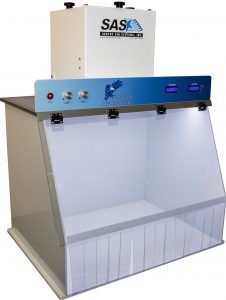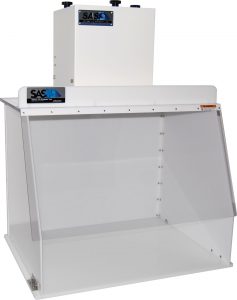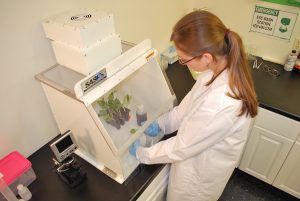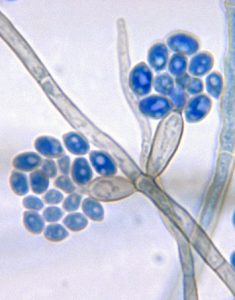
Micrograph of a fungal organism Exophiala Salmonis. (Source)
Mycology, a branch of biology, focuses on the study of fungi. Heinrich Anton de Bary, a research botanist from Germany in the 1800s, is credited for his ground-breaking research on fungi-related plant diseases, which laid the foundation for modern mycology and plant pathology.
The field of mycology is vast and includes a wide array of research focuses, including:
• Medical and Pharmacological Research
• Fungal Genetics
• Fungal Infections and Diseases (in plants, humans, and animals)
• Agriculture and Environmental Uses
• Food and Beverage (Beer, Wine, Bread, Yeast, etc.)
Some of the more notable contributions that mycological research has provided are the development of antibiotic and cholesterol-lowering drugs including penicillin, streptomycin, and tetracycline.
Sampling and Testing
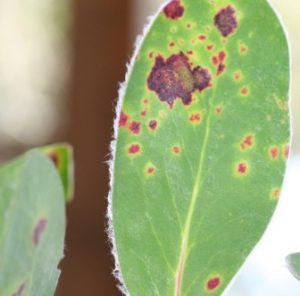
Leaf Specimen with Fungi (Source)
When studying fungi, mycologists take several samples for testing and research. Depending on the area of study, samples may include:
• Plants and Mushrooms
• Mold
• Nails
• Hair
• Skin
• DNA
• Urine
• Tissue Biopsies
These samples are then tested and analyzed to determine the type of fungus present as well as its effect (positive or negative) on the host sample.
It is important for researchers and laboratory technicians to guard their respiratory health when handling these samples; particularly those in the field of fungal infection and disease research. Microscopic fungal strains, as well as human or animal hair, urine, tissue, and DNA may pose a respiratory risk if inhaled during processing and analysis.
Recommended Laboratory Safety Standards
According to the Center for Disease Control’s Guidelines for Safe Work Practices in Human and Animal Medical Diagnostic Laboratories, it is “recommended that mycology laboratories that culture for filamentous fungi and manipulate those organisms be separate and isolated from the main microbiology laboratory with negative air pressure moving into the room from the main laboratory.” (CDC)
The Guideline further states that “every diagnostic microbiology laboratory needs one or more BSC as a primary means of containment for working safely with infectious organisms.” In chapter 3 of the Guideline, the CDC refers to using HEPA filters that remove at least 99.97% of 0.3 µm particles. The use of a negative-pressure work zone, coupled with a HEPA filter, is a proven safety measure that helps protect workers from inhalation exposure to hazardous-laden microscopic particles. Ductless Fume Hoods and Portable Clean Rooms would both provide safety measures to protect the user and environment from harmful mycology samples.
Portable, Ductless Fume Hoods for Laboratory Workstations
Ductless Fume Hoods, also known as Ductless Containment Hoods, are self-contained negative-pressure workstations that help protect the operator’s breathing zone from harmful airborne fumes and particulates.
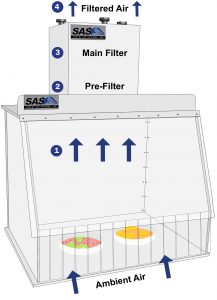
2. The air within the hood is processed through a pre-filter where some particles are captured.
3. Air is filtered through the main filter (HEPA, ULPA, ASHRAE, Activated Carbon or Specialty Blended).
4. Filtered air is released back into the room eliminating the need for ductwork.
Utilizing a powerful fan, ambient air is pulled in through the hood’s inlet and into a filtration system. The filters work to keep harmful airborne contaminants away from the operator’s respiratory zone while they work within the hood. Because the air is recirculated, no exterior-ducting or loss of heat and air conditioning is necessary when using a fume hood.
Sentry AirHawk — Model # AirHawk30
Features: Multi-level Filter Chamber*, Variable Speed Control, and Dimmable 1400 Lux LED Light
*If solvents are being utilized, the filter chamber will have an optional activated carbon filter.
Approx. Inlet Velocity:
Pre-filter & 99.97% HEPA Filter – 130 FPM High; 25 FPM Low
Pre-filter & Heavy-duty Carbon Filter – 115 FPM High; 20 FPM Low
Multiple widths available: 30″ (shown), 40″, 50″
For additional visibility, the hood can be made of all clear PVC.
30” and 40” Wide Ductless Fume Hood —
Model # SS-330-DCH and SS-340-DCH
Features: Variable Speed Control and a Fluorescent Light
Approx. Inlet Velocity:
Pre-filter & 99.97% HEPA Filter – 130 FPM High; 25 FPM Low
Pre-filter & Heavy-duty Carbon Filter – 115 FPM High; 20 FPM Low
Multiple widths available:
12″, 18″, 24″, 30” (shown), 40′, 50″, 60″, 70″
For additional visibility, a transparent version is available at extra cost.
Utilizing Positive Pressure for Laboratory Work
There are some instances during mycology work where samples need to be kept under positive pressure in order to not cross contaminate. For these applications, a Portable Clean Room Hood (PCR) is an excellent solution.
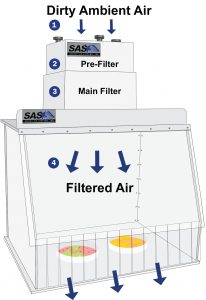
1. Room air is pulled into the air cleaner.
2. Air is processed through a MERV 8 Pre-Filter, where some particles are absorbed.
3. Air is filtered by passing through a final HEPA (up to 99.97% efficiency on particles as small as 0.3 microns) or ULPA (up to 99.9997% efficiency on particles as small as 0.12 microns) Filter.
4. Filtered air is discharged into the work area of the hood in a vertical laminar flow pattern, creating a particle-free enclosure.
18” Wide Portable Clean Room Hood —
Model # SS-218-PCR
All of Sentry Air’s PCRs have an ISO Class 5 rating, utilize a dual-stage filtration process consisting of a pre-filter and a HEPA or ULPA filter, and come in a variety of sizes. The 18” PCR in particular, can be easily integrated into existing workspaces because of its size and can be transported to various locations without difficulty because of its lightweight and portable nature.
Sources
• WiseGeek – What Does a Mycologist Do? https://www.wisegeek.com/what-does-a-mycologist-do.htm
• Wikipedia – Mycology, https://en.wikipedia.org/wiki/Mycology
• Britannica – Mycology, https://www.britannica.com/science/mycology
• Britannica – Heinrich Anton de Bary, https://www.britannica.com/biography/Heinrich-Anton-de-Bary#ref232082
• CDC – Guidelines for Safe Work Practices in Human and Animal Medical Diagnostic Laboratories, https://www.cdc.gov/mmwr/pdf/other/su6101.pdf (Chapters 3 and 7)

 Made in the USA
Made in the USA
